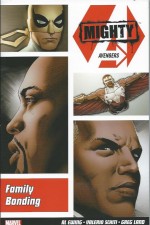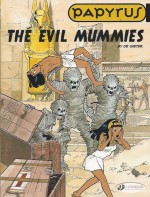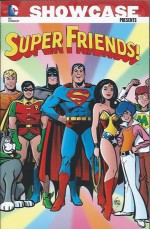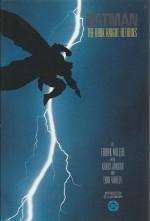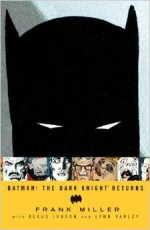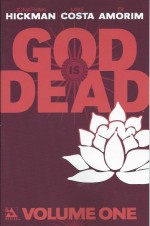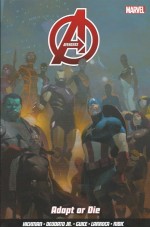
By Jonathan Hickman, Salvador Larroca, Mike Deodato Jr., Butch Guice, Esad Ribic, Steve Pugh & various (Marvel/Panini UK)
ISBN: 978-1-84653-583-3
Following an unending string of universe-shattering crises, Iron Man and Captain America swallowed old animosities and united to reshape The Avengers into a planetary defence force more army than voluntary association, with more than twenty active members – human or alien or something less clear cut – whose specialities range from stealth and counter-intelligence to sheer, blockbusting stopping power.
The posture and attitude also changed as the new group actively sought out potential disaster points rather than waiting for trouble to start.
Collecting Avengers volume 5 #24-28 (covering December 2013 to April 2014), the ongoing Big Picture series as scripted by Jonathan Hickman and illustrated Salvador Larroca, Mike Deodato Jr., Butch Guice, Esad Ribic & Steve Pugh continues to lay down the law, beginning with a Christmas present from 3030AD…
From that distant tomorrow comes a far-futuristic iteration of the Armoured Avenger bearing a timely warning of danger to interrupt a much-needed decompression barbecue on top of Avengers Tower.
Inside the building Steve Rogers and Tony Stark are working. Following twin invasions by the extra-galactic Builders and Thanos of Titan plus a mutagenic plague of new metahumans triggered by the Inhumans (Infinity and Inhumanity), the master strategists are readying the latest design of their “Avengers Machine†for safeguarding mankind…
On materialisation Iron Man 3030 panics. This cannot be the right place or time. There are heroes present that history never recorded as Avengers…
After the mandatory clash of arms the situation settles enough for the assemblage to take heed of the time-traveller who warns that a ‘Rogue Planet’ has been aimed at the Earth like a giant bullet…
With time to prepare, the heroes relocate to their frontier outpost on Mars and enact a truly original solution which leaves Earth with a monolithic secret weapon for future emergencies…
A chilling murder mystery then begins when size-changing savant Hank Pym is found dead amongst a mass of slaughtered New Yorkers in ‘Carve a Hole… Climb Inside’. With an Avenger murdered, S.H.I.E.L.D. Director Maria Hill makes the case her topmost priority…
As the investigation proceeds, the truth slowly comes out. Resurgent techno-terrorist cabal A.I.M. has been unwisely exploring the fringes between universes and plucked a sextet of Avengers from their own Earth in the moments before it died as part of the ongoing collapse of the multiverse.
As previously established, Reality is composed of discrete universes all held apart by an infinite crimson underspace dubbed the Superflow. Now that immemorial barrier is somehow fragmenting, with the timeless alien engineers who maintain it helpless to stop the carnage whenever an Earth drifts into contact with another Earth. On those occasions at least one is always obliterated…
A.I.M. has no grudge against their rescued finds and lets them loose upon the world as they prepare for the next phase of their research into other dimensions. Unfortunately General America, Thorr, Iron Monger, Ant-Man, Wasp and their lobotomised Hulk are no heroes and establish their credentials by slaughtering an entire district of annoying New Yorkers…
In ‘Look Around… There’s No Way Out’ Director Hill’s suspicions prove unfounded as the real Avengers go into action and the true facts unfold.
Months ago A.I.M., using genetic material stolen from the World’s Mightiest Heroes, upgraded their latest design of Super-Adaptoid, intent on tasking the six uncanny mechanoids with exploring the void between universes. The crazy scientists unwisely made their creations autonomous, self-aware and able to draw on an armoury of Avenger abilities: well able to mine the multiverse for technological treasures.
They never considered that new experiences might reshape their creatures’ programming or desires and foolishly despatched the Adaptoids to capture the extra-dimensional Avengers as they ran amok on Earth. In the resultant clash Ant-Man was killed and the enslaved Hulk broke free and fled…
Reverting to Bruce Banner the trans-dimensional fugitive made for a safe house he hoped his doppelganger also secretly maintained, whilst at A.I.M. HQ the Explorer Class Adaptoids took advantage of their newly-won free will and seized control of their own destinies…
‘Only Dirt… Six Feet Deep’ opens with Dr. Banner coming face to face with his other-Earthly counterpart and taking a very uncharacteristic chance even as on A.I.M. Island the Scientist Supreme reacts very badly to the news that his prime experiment is completely out of control. The variant Avengers have made savage contact with this Earth’s heroes and a devastating battle is wrecking the Big Apple. He wants all evidence of A.I.M. involvement eradicated…
The battle is just going the good guys’ way when an utterly out of control Hulk turns up and attacks everyone, giving the A.I.M. units a perfect opportunity to step in and surreptitiously extract the evil Avengers…
In the aftermath Bruce confronts Tony Stark, carrying ‘The Case’ and claiming to have deduced the billionaire inventor’s long-term goals. In a tense stand-off he reveals that he – not his double – was recovered by A.I.M. forces and has subsequently ensured that the evil Avengers will not be back.
Even as Captain America was agreeing to surrender the rampaging out of control Hulk to Maria Hill’s custody, Banner was learning from the Scientist Supreme that all the universes are dying – a fact Stark has concealed from his team-mates.
The rogue physicist reasoned the how and why of Iron Man’s recent actions and drive to reshape the Avengers. He also deduced that Stark had reformed the intellectual star-chamber dubbed The Illuminati to make all the really hard decisions and take those actions his fellow heroes would baulk at…
As Stark admits everything and makes Banner a shocking offer, in the trans-dimensional void the free will Adaptoids meet something strangely familiar and begin their next evolution…
To Be Continued…
A spectacular Fights ‘n’ Tights overload that will delight and astonish lovers of cosmic Costumed Dramas, this tome also offers a stunning 28 covers-and-variants gallery by Ribic, Deodato Jr., Agustin Alessio, Simone Bianchi, Joe Quinones, Carlo Barberi, J. Scott Campbell, Daniel Acuña, John Tyler Christopher, Lee Garbett, Tom Scioli, Walt Simonson, Art Adams, Michael Allred, Kris Anka, Alex Ross and Dustin Weaver, as well as digitally-diverting extra content for tech-savvy consumers courtesy of AR icon sections all accessible through a free digital code and the Marvel Comics app for iPhone®, iPad®, iPad Touch® & Android devices at Marvel’s Digital Comics Shop.
™ and © 2014 Marvel & Subs. Licensed by Marvel Characters B.V. through Panini S.p.A. All rights reserved. A British Edition published by Panini Publishing, a division of Panini UK, Ltd.


